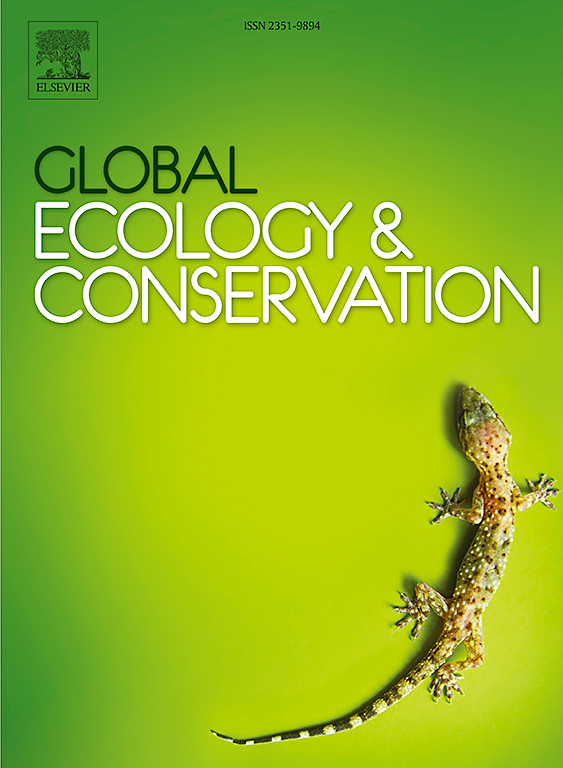Integrating MaxEnt and InVEST modeling methods to identify priority areas for the conservation of emblematic and endemic wildlife in the Peruvian Tropical Andes
IF 3.4
2区 环境科学与生态学
Q1 BIODIVERSITY CONSERVATION
引用次数: 0
Abstract
The habitat of emblematic and endemic species in the Tropical Andes of Peru is particularly vulnerable to environmental degradation due to anthropogenic activities. This study aimed to identify new spatial priority areas for the conservation of two endemic (Aotus miconax and Lagothrix flavicauda) and one emblematic (Tremarctos ornatus) fauna species in the Peruvian Tropical Andes (PTAs). In order to establish an innovative approach to conservation planning, we conducted the MaxEnt-InVEST modeling method, integrating the threatened species distribution and habitat quality models. The analysis revealed that 79.00 % of the integrated model priorities of conservation areas (IMPCA) are currently unprotected, and about 21.05 % of the IMPCA are identified as high-priority zones or core zones that fall outside the boundaries of the existing natural protected areas (NPAs) within the PTAs. While the IMPCA are distributed throughout the PTA, a greater density is observed in the northern zone. In addition, only 12.80 % of the IMPCA is within the current NPAs. Also, 8.20 % of the area is not included in the integrated model. Finally, 30.87 % of the IMPCA has been allocated to the current degraded areas identified by the Peruvian government. Consequently, it is imperative to advocate for collective action to restore these areas for the benefit of the species A. miconax, L. flavicauda and T. ornatus, as well as biodiversity and sustainable development. The integrative MaxEnt-InVEST method is a powerful tool for conservation policy because of it provides useful data that can support decisions at national and international levels to assess the effectiveness of NPAs in maintaining ecological functionality. These results provide valuable insights for policy makers and conservation practitioners in their efforts to protect and sustainably manage the unique biodiversity of the PTAs.
整合MaxEnt和InVEST建模方法,确定秘鲁热带安第斯山脉标志性和特有野生动物保护的优先区域
秘鲁热带安第斯山脉的标志性和特有物种的栖息地特别容易受到人为活动造成的环境退化的影响。本研究旨在为秘鲁热带安第斯山脉(PTAs)两种特有物种(Aotus miconax和Lagothrix flavicauda)和一种标志性动物(Tremarctos ornatus)确定新的空间优先保护区域。为了建立一种创新的保护规划方法,我们进行了MaxEnt-InVEST建模方法,将濒危物种分布和栖息地质量模型整合在一起。分析结果表明,79.00 %的综合模式优先保护区(IMPCA)目前未受保护,21.05 %的IMPCA被确定为高优先区或核心区,这些区域位于保护区内现有自然保护区(NPAs)的边界之外。虽然IMPCA分布在整个PTA,但在北部地区密度较大。此外,只有12.80 %的IMPCA在目前的国家行动纲领范围内。此外,8.20 %的面积未包括在综合模型中。最后,30.87 %的IMPCA已分配给秘鲁政府确定的当前退化地区。因此,倡导采取集体行动,恢复这些地区的物种,以造福于A. miconax, L. flavicauda和T. ornatus,以及生物多样性和可持续发展是势在必行的。综合的MaxEnt-InVEST方法是保护政策的有力工具,因为它提供了有用的数据,可以支持国家和国际层面的决策,以评估国家保护区在维持生态功能方面的有效性。这些结果为政策制定者和保护工作者保护和可持续管理保护区独特的生物多样性提供了有价值的见解。
本文章由计算机程序翻译,如有差异,请以英文原文为准。
求助全文
约1分钟内获得全文
求助全文
来源期刊

Global Ecology and Conservation
Agricultural and Biological Sciences-Ecology, Evolution, Behavior and Systematics
CiteScore
8.10
自引率
5.00%
发文量
346
审稿时长
83 days
期刊介绍:
Global Ecology and Conservation is a peer-reviewed, open-access journal covering all sub-disciplines of ecological and conservation science: from theory to practice, from molecules to ecosystems, from regional to global. The fields covered include: organismal, population, community, and ecosystem ecology; physiological, evolutionary, and behavioral ecology; and conservation science.
 求助内容:
求助内容: 应助结果提醒方式:
应助结果提醒方式:


